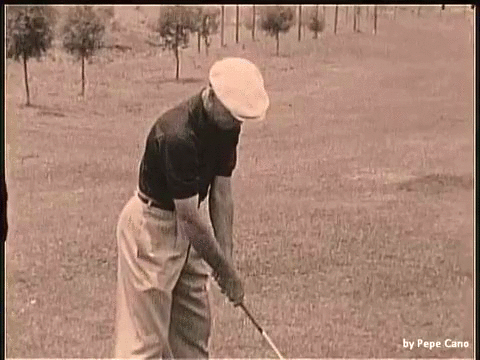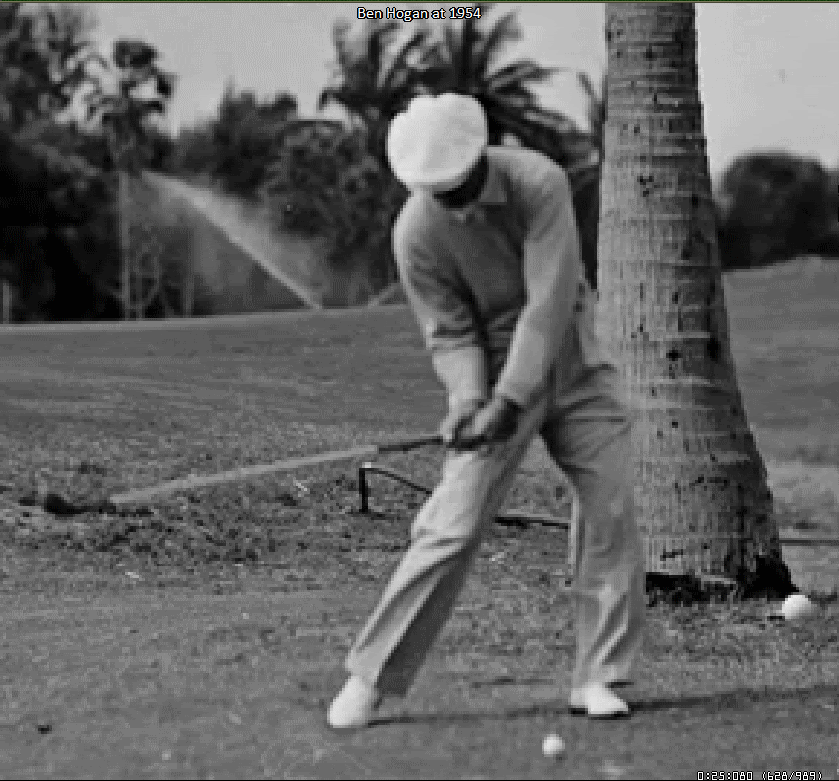In "The Arms Situation" section, we learnt that scapular protraction and depression in the shoulder area helps vividly in automating the upper body and arms movement thanks to introducing necessary stabilization. There is, however, another interesting element that this time links the trigger compression and the virtues described in the above section. Furthermore, adapting the element can help in obtaining desired clubhead angle at impact already practically before start of the backswing. I decided to call the element The Bridge. In the view of Cary Middlecoff's opinion that one can read later on in this article, this element can be probably the last puzzle in the Hogan's secret, that made him get rid of the chronic hook and without what Hogan couldn't have said "the stronger I hit the better it went".
Let us start here with the address setup with both scapulae protracted and depressed creating the compact look of tightly unified arms. As we know from the Sagittal Plane Compression concept, the motion should start with the trigger compression phase aimed at rocking the swing up and building momentum that is being passed from the ground up and the core out later to further parts of the body within the frame of the chain of the unintentional events. This phase, known in popular golf language as the forward press, can have variety of forms starting from a simple rear knee targetwise movement and ending at an anticlockwise circular motion of the whole body. Recently, when watching post-secret and, especially, post-accident Hogan while preparing material for the vid 'Secret', I have noticed that the master often (I repeat and underline: often which means not always -- we shall revert to it later on) added a not very well visible but, as it appears, a crucial move that accompanies his head preset clockwise rotation (typical for LED persons), namely, a combination of a rear humerus external rotation with a slight rear arm extension.
It looks as the distance between both shoulder joints even decreases and feels as the contraction of rear tricep both pushes the humerus forward while slightly rotating it externally. Please remember that shoulder area external rotation occurs always in the takeaway/backswing phase, thus, its earlier presence assists vividly further in the process, the more it does not affect rear shoulder protraction that was established already during the setup phase. As far as the rear arm extension part goes, it is responsible for creating width in the backswing as well as prevents the lead arm from collapsing (the so-called backswing extensor action known in many golf schools).
The most intriguing part (as for Hogan and his quest to eliminate dreadly hook) lies in impact on clubface angle that The Bridge move exerts. Forcing rear humerus to rotate externally presets automatically the clubface open from the very first part of the swing. Moreover, taking into account that protraction (mainly thanks to the combination with depression) preset at address can last the whole motion until impact (thanks to a proper activation of the famous serratus anterior muscle) we can easily see that it is tougher to close the clubface too much at impact. I have observed that it is a great tool to decide how closed clubface we want at impact and, therefore, to decide about a desired shot shape. I have also observed that the left side of the course is being practically eliminated (not coincidentally it is what Hogan wanted), especially, when we apply stronger pivot.
Creme de la creme of the whole story is, perhaps the first succesful attempt to depict what Hogan was jealous of Jimmy Bruen, the 1938 Walker Cup wonder. There is a lesser known interview with Mike Austin who mentioned that Hogan, while recovering after the fatal car accident, dreamt about ability to eliminate the left side of the course as James Bruen had been doing. It appears that the Irishman used exactly the same Bridge move that Hogan implemented later on into his post-accident swing, with even more pronounced clubhead face fanning open.
Was it the real secret ? I cannot tell but sure it could have been an important part of the secret. Nevertheless, it is worth stressing that old Mr.Hogan, on the famous beach vid, shows that the Bridge move was an integral conscious part of the swing. Otherwise, he would not have performed it during that show for sure and his trigger compression move was simplier and affected only lower half of the body.
Last but not least, what has also struck me lately are Cary Middlecoff's words about Hogan that I have found in his great book titled "The Golf Swing". He wrote: "According to my memory, it was in 1950, after the accident, that he began showing us the kind of precision golf that set him apart. [...] I kept thinking that he was a far better tee-to-green golfer than I remembered from our many rounds together in 1948. It was in 1950 that he began to take on the miracle-man aura." If Doc was right, it is post-accident Hogan that we should pay attention to, not just post-secret. Just to add, reverting to our current topic, watching rare available post-secret pre-accident footages we will not observe The Bridge move...nevertheless, it would have been impossible for Hogan to invent this particular move without previous discoveries about scapular protraction and depression that, among others, differ his pre-secret motion from the post-secret one.

























